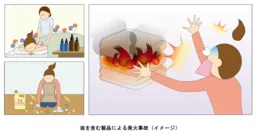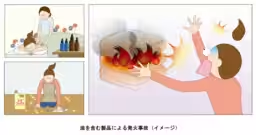

Danger of Spontaneous Combustion of Oil Products in Summer Heat
Understanding the Risks of Oil Combustion in Summer
As we enter the hot summer months, an important warning comes from the National Institute of Technology and Evaluation (NITE) regarding the risks of spontaneous combustion related to oil products. Hot weather increases the likelihood of oil igniting due to its chemical composition and environmental conditions.
Why Do Oil Fires Happen?
Oil contains fatty acids that can become hazardous. Specifically, unsaturated fatty acids, which are abundant in many oils, are prone to oxidation, a chemical reaction where oxygen interacts with the fatty acids, producing heat. If enough heat accumulates, it can lead to spontaneous combustion without any external ignition source.
For instance, when towels soaked in massage oils or aroma oils are dried in a machine without proper cooling, they can hold internal heat and potentially catch fire. Similarly, if large amounts of cloth or paper, which have been contaminated with wax or paint, are left unattended, they can also lead to combustion. This issue becomes more pressing in hot environments where heat dissipation is limited.
Points to Consider
- - Avoid Heating Oily Fabrics: Always refrain from using a dryer for fabrics saturated with oils after washing. Strong detergents should be employed to break down the oily residues thoroughly.
- - No Storage in Bags: After cleaning towels or papers that have absorbed oily substances, do not leave them folded or bagged for an extended period. Instead, make sure they are rinsed thoroughly and disposed of safely.
- - Check Labels Carefully: Upon purchasing oil-containing products, check for safety labels indicating any warnings related to heat or flames. For safety, avoid direct sunlight and store them correctly to prevent accidents.
The Nature of Oily Substance Fires
Oils that are rich in unsaturated fatty acids such as oleic acid from jojoba oil, linoleic acid found in grapeseed oil, and alpha-linolenic acid in flaxseed oil are especially vulnerable to combustion. These unsaturated acids can easily undergo oxidation, producing heat. In climates with high temperatures, the heat generated from the oxidation reaction may not escape, resulting in increased combustion risks. The so-called flashpoint, the minimum temperature at which a substance can ignite without an external ignition source, becomes essential to understand in these circumstances.
What Can You Do?
- - Use proper washing techniques for oily fabrics, and dry them in well-ventilated areas instead of machines.
- - Dispose of any oily materials safely by soaking them in water before disposal to mitigate combustion risks.
- - Always consult product labels for critical information regarding safe handling and storage practices.
NITE Safeguards
To assist consumers in managing product safety, NITE provides an online resource called NITE SAFE-Lite, which offers a searchable database for product-related accidents and recalls based on user-friendly product names. You can explore this service here.
In Conclusion : As the heat rises, it's vital to re-evaluate how we handle products containing oils. Such precautions not only ensure your safety but also help prevent potential disasters. With a little caution and awareness, we can enjoy a safe and worry-free summer season.








Topics Policy & Public Interest)










【About Using Articles】
You can freely use the title and article content by linking to the page where the article is posted.
※ Images cannot be used.
【About Links】
Links are free to use.